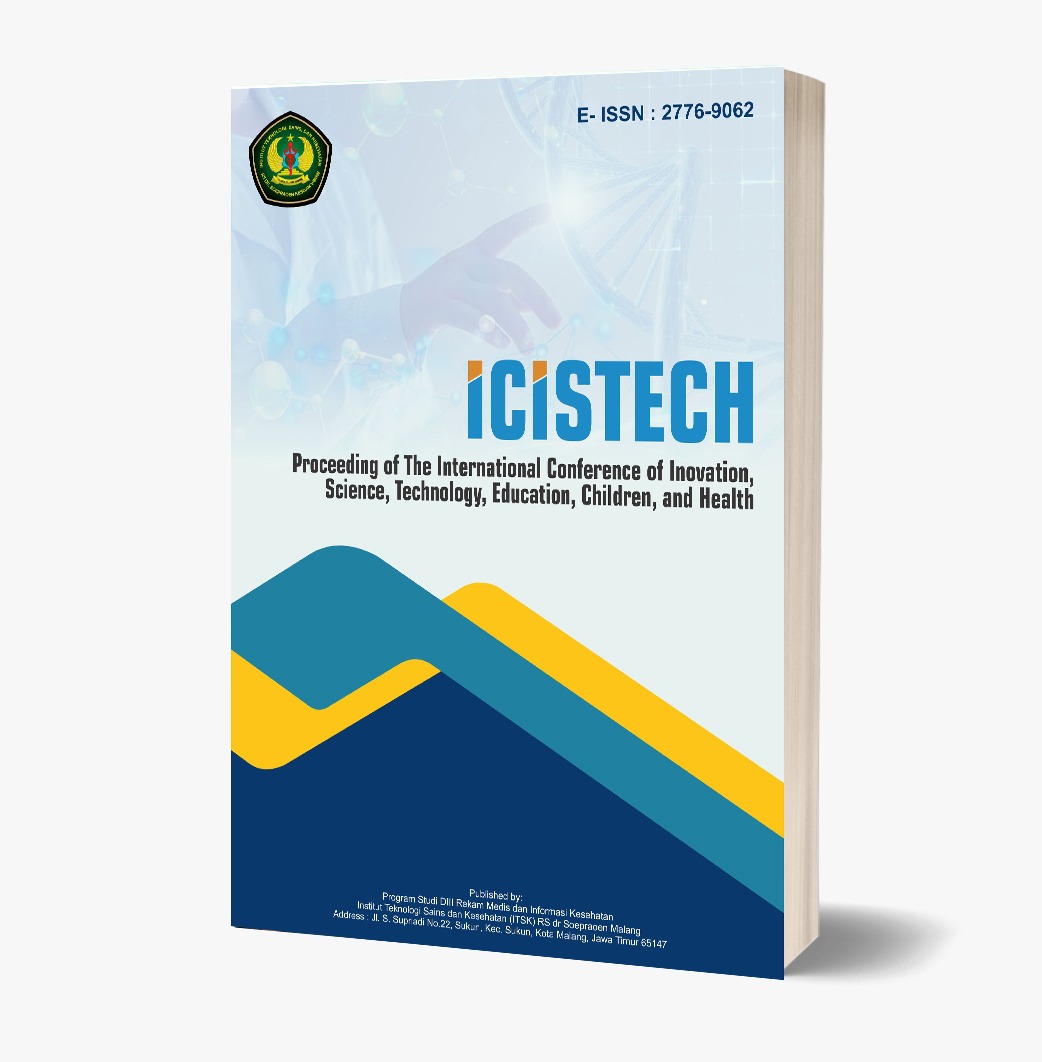Building Internalization of Early Childhood Learning through Collaborative Learning
DOI:
https://doi.org/10.62951/icistech.v3i1.45Keywords:
Collaborative Learning, Early Childhood Learning, Family Education, Learning StylesAbstract
The context of teaching and learning in the era of the COVID-19 pandemic provides more space for families to teach their children, especially at an early age. Therefore, the purpose of this study is to examine the phenomenon of family-based early childhood learning starting from literature studies, problems to solutions in overcoming these problems. The solution that is the key to successful learning in the family environment is the internalization of what parents teach their children. The author uses a collaborative learning design in its application. This solution will direct the child to find a learning style that suits him. This is certainly beneficial for parents in making it easier to teach their children. Therefore, it is hoped that the existence of this research study can be an alternative reference for parents in teaching their children, especially at the early age level which is the rapid development of the brain in receiving various external information around it.
References
Akhrif, O., Benfares, C., El Bouzekri El Idrissi, Y., & Hmina, N. (2020). Collaborative approaches in smart learning environment: A case study. Procedia Computer Science, 175, 710–715. https://doi.org/10.1016/j.procs.2020.07.105
Amiruddin, A. (2019). Pembelajaran kooperatif dan kolaboratif [Cooperative and collaborative learning]. Journal of Education Science, 5(1).
Apriyanti, H. (2017). Pemahaman guru pendidikan anak usia dini terhadap perencanaan pembelajaran tematik [Understanding of early childhood education teachers regarding thematic learning planning]. Jurnal Obsesi: Jurnal Pendidikan Anak Usia Dini, 1(2), 111–117.
Asbar, A., Kasdir, K., & Elihami, E. (2020). Blended of learning styles through creative and critical thinking. Edumaspul: Jurnal Pendidikan, 4(2), Article 2.
Ballarino, G., & Versino, P. (2017). Family background and educational ambitions of second-generation children in Europe. (Unpublished doctoral dissertation). Università degli Studi di Milano, Milan.
Benner, A. D., & Mistry, R. S. (2020). Child development during the COVID-19 pandemic through a life course theory lens. Child Development Perspectives, 14(4), 236–243. https://doi.org/10.1111/cdep.12382
Bhamani, S., Makhdoom, A. Z., Bharuchi, N., Ali, S., Kaleem, S., & Ahmed, D. (2020). Home learning in times of COVID: Experiences of parents. Journal of Education and Educational Development, 7(1), 9–26.
Carr, M., Morris, J., & Kersten, P. (2020). Developing clinical expertise in musculoskeletal physiotherapy: Using observed practice to create a valued practice-based collaborative learning cycle. Musculoskeletal Science and Practice, 50, 1–6. https://doi.org/10.1016/j.msksp.2020.102278
Carstensen, S. S., Kjaer, C., Möller, S., & Bloksgaard, M. (2020). Implementing collaborative, active learning using peer instructions in pharmacology teaching increases students’ learning and thereby exam performance. European Journal of Pharmacology, 867, 172792. https://doi.org/10.1016/j.ejphar.2019.172792
Dillenbourg, P. (1999). What do you mean by ‘collaborative learning’? In Collaborative-learning: Cognitive and computational approaches (pp. 1–19). Oxford: Elsevier.
Edwards, J. D., Panitch, H. B., Nelson, J. E., Miller, R. L., & Morris, M. C. (n.d.). Decisions for long-term ventilation. Annals of the American Thoracic Society, 17(1), 72–80.
Guo, Q., Zhao, C., Xu, J., Li, Y., & Yang, F. (2020). Online knowledge distillation via collaborative learning. In Proceedings of the IEEE/CVF Conference on Computer Vision and Pattern Recognition (pp. 11020–11029).
Hatami, S. (2013). Learning styles. ELT Journal, 67(4), 488–490. https://doi.org/10.1093/elt/ccs083
Iborra, A., García, D., Margalef, L., & Pérez, V. (2010). Generating collaborative contexts to promote learning and development. In Collaborative learning: Methodology, types of interactions and techniques (pp. 47–80).
Janssen, L. H., Drossaert, C. H., Westerhof, G. J., & de Lange, A. (2020). Does the COVID-19 pandemic impact parents’ and adolescents’ well-being? An EMA-study on daily affect and parenting. PLOS ONE, 15(10), e0240962. https://doi.org/10.1371/journal.pone.0240962
Järvelä, S., Gašević, D., Seppänen, T., Pechenizkiy, M., & Kirschner, P. A. (2020). Bridging learning sciences, machine learning, and affective computing for understanding cognition and affect in collaborative learning. British Journal of Educational Technology, 51(6), 2391–2406. https://doi.org/10.1111/bjet.12855
Kuswandi, D., Suryadi, K., & Fitriani, R. (2020). The role of educational technologists in building the skills of early childhood teachers with TRINGO Ki Hadjar Dewantara approach. In 2nd Early Childhood and Primary Childhood Education (ECPE 2020) (pp. 138–143).
Laal, M., & Ghodsi, S. M. (2012). Benefits of collaborative learning. Procedia - Social and Behavioral Sciences, 31, 486–490. https://doi.org/10.1016/j.sbspro.2011.12.092
Laal, M., & Laal, M. (2012). Collaborative learning: What is it? Procedia - Social and Behavioral Sciences, 31, 491–495. https://doi.org/10.1016/j.sbspro.2011.12.093
McLanahan, S., & Percheski, C. (2008). Family structure and the reproduction of inequalities. Annual Review of Sociology, 34, 257–276. https://doi.org/10.1146/annurev.soc.34.040507.134549
Morris, S. E., Moment, A., & deLima Thomas, J. (2020). Caring for bereaved family members during the COVID-19 pandemic: Before and after the death of a patient. Journal of Pain and Symptom Management, 60(2), e70–e74. https://doi.org/10.1016/j.jpainsymman.2020.05.022
Olanipekun, T., Effoe, V., Bakinde, N., Bradley, C., Ivonye, C., & Harris, R. (2020). Learning styles of internal medicine residents and association with the in-training examination performance. Journal of the National Medical Association, 112(1), 44–51. https://doi.org/10.1016/j.jnma.2019.12.002
Prime, H., Wade, M., & Browne, D. T. (2020). Risk and resilience in family well-being during the COVID-19 pandemic. American Psychologist, 75(5), 631–643. https://doi.org/10.1037/amp0000660
Romero-Tena, R., Barragán-Sánchez, C., Llorente-Cejudo, M., & Palacios-Rodríguez, A. (2020). The challenge of initial training for early childhood teachers: A cross-sectional study of their digital competences. Sustainability, 12(11), 4782. https://doi.org/10.3390/su12114782
Romero-Tena, R., López-Lozano, R., & Gutiérrez, M. P. (2020). Types of use of technologies by Spanish early childhood teachers. European Journal of Educational Research, 9(2), 511–522. https://doi.org/10.12973/eu-jer.9.2.511
Satgas Penanganan COVID-19. (2021). Peta sebaran [Map of distribution]. COVID-19 Task Force. https://covid19.go.id/peta-sebaran (Accessed January 29, 2021).
Setyosari, P. (2009). Pembelajaran kolaborasi landasan untuk mengembangkan keterampilan sosial, rasa saling menghargai dan tanggung jawab [Collaborative learning as a basis for developing social skills, mutual respect, and responsibility]. Pidato Pengukuhan Guru Besar dalam Bidang Ilmu TEP pada FIP UM disampaikan pada sidang terbuka Senat UM, 14.
Thaariq, Z. Z. A., & Wedi, A. (2020). Model adaptive blended curriculum (ABC) sebagai inovasi kurikulum dalam upaya mendukung pemerataan pendidikan [Adaptive blended curriculum (ABC) model as a curriculum innovation to support educational equity]. Jurnal Kiprah, 8(2), 91–104.
Trentin, G. (2010). Technology-enhanced learning and networked collaborative learning. In Networked Collaborative Learning (pp. 1–22). Oxford: Chandos Publishing.
Wu, L., Liu, Q., Mao, G., & Zhang, S. (2020). Using epistemic network analysis and self-reported reflections to explore students’ metacognition differences in collaborative learning. Learning and Individual Differences, 82, 1–10. https://doi.org/10.1016/j.lindif.2020.101913
Yafie, E., Samah, N. A., Mohamed, H., & Haqqi, Y. A. (2020). Collaborative mobile seamless learning (CMSL) based on Android apps to improve critical thinking in higher education in the post-COVID-19 era. Journal of Advanced Research in Dynamical and Control Systems, 12(7), 428–441.
Zhi, X. S., Ghosh, S., & Cox, K. (2020). Impact of a case-based collaborative learning curriculum on knowledge and learning preferences of dermatology residents. International Journal of Women’s Dermatology, 6(5), 404–408. https://doi.org/10.1016/j.ijwd.2020.06.002
Downloads
Published
How to Cite
Issue
Section
License
Copyright (c) 2023 Proceeding of The International Conference of Inovation, Science, Technology, Education, Children, and Health

This work is licensed under a Creative Commons Attribution-ShareAlike 4.0 International License.













